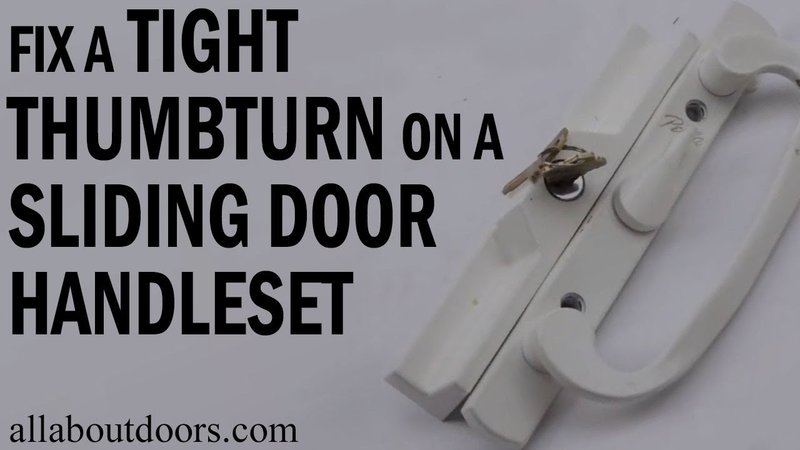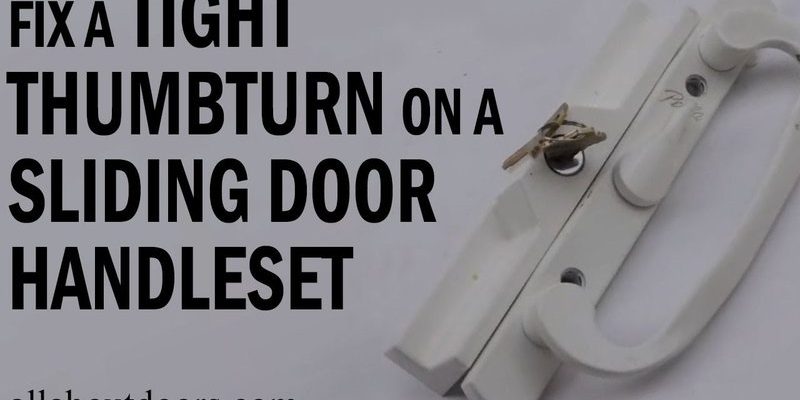
You might wonder if this is something minor or a sign your lock is on its last legs. Is a quick squirt of lubricant enough, or are you staring down the barrel of a costly replacement? Let me explain where that roughness comes from, what it means, and how to fix it so your door opens as smoothly as it should.
Why Does My Handleset Feel Rough When Turning?
When a handleset feels rough, it usually means something inside isn’t moving the way it should. Think of it like trying to pedal a bike with a rusty chain—everything technically works, but the ride is bumpy. Most handlesets, whether they’re from Baldwin, Kwikset, or Schlage, use a series of small metal parts that need to glide over each other smoothly.
Here’s the thing: dirt, dust, and old lubricant are the main troublemakers. Over time, even a high-quality lock will collect tiny bits of debris. Maybe someone spilled coffee by the door, or maybe it’s just general grime. That gunk gums up the works and, before you know it, turning the handleset feels like dragging a brick through sand.
Sometimes, though, roughness isn’t just about dirt. Internal components—like springs, spindles, or the latch—can wear down or fall out of alignment. Even something as small as a loose screw can mess up how everything turns. If you’ve got a smart lock or an electronic handleset, you could be dealing with a low battery or a code-sync issue, but for most traditional locks, it’s usually about mechanical friction.
Common Signs of Handleset Trouble
You might be tempted to ignore a rough-feeling lock, but honestly, that’s never a good idea. A sticky handleset is often a warning sign that something else is about to go wrong. Here’s what usually shows up first:
- Grinding or scraping sounds: If your lock sounds like a squeaky door hinge, it probably needs a clean or some fresh grease.
- Unusual resistance: If turning the knob or lever feels harder than usual, there’s probably friction building up inside.
- Key gets stuck or is hard to remove: That’s a big hint the cylinder or latch isn’t working right.
- Handle doesn’t return to its original position: Springs or internal parts could be worn or misaligned.
Don’t wait for the day your door simply won’t open. If you catch these problems early, you can usually fix your handleset before it fails completely.
Quick Checks Before You Start Fixing
Before you grab your toolbox, it’s smart to rule out a few simple causes. Sometimes, the fix is way easier than you’d expect.
- Check for dirt and debris: Look closely at the area around the handle and keyhole. Wipe away visible dust, dirt, or gunk. A simple cleaning with a cloth can sometimes do wonders.
- Examine both sides of the door: Make sure nothing is blocking the handle’s movement from inside or outside.
- Try another key: If you have a spare that’s in better shape, use it. Sometimes, worn-down keys can cause roughness.
- Test with the door open: Turning a handleset with the door ajar removes the latch from the equation. If it feels smoother, the problem might be with the door alignment, not the lock itself.
If you spot obvious issues here, you might be able to skip more involved troubleshooting. If not, it’s time to dig deeper.
Step-by-Step Troubleshooting for a Rough Handleset
Now, let’s get into the guts of the problem. You don’t have to be a locksmith to try these steps—just a bit patient and willing to get your hands dirty.
- Lubricate the moving parts: Get a graphite or silicone-based lock lubricant (never regular WD-40—it attracts grime). Spray a small amount into the keyhole, handle pivot points, and latch mechanism. Turn the handle several times to work the lubricant in.
- Remove and inspect the handleset: If lubrication doesn’t help, unscrew the handleset from the door. Set all parts aside carefully on a towel so nothing gets lost. Look for obvious wear, bent pieces, or stripped screws.
- Clean everything: Use a soft brush or compressed air to remove dust from the internal parts. Wipe metal pieces with a cloth—mild soapy water works well, but dry thoroughly afterward.
- Check spring tension: Many rough turns are caused by weak or broken springs inside the latch or handle. If the handle feels floppy or doesn’t bounce back, replacing the spring might be necessary.
- Reassemble and test: Put the lock back together, taking care to align everything precisely. Test the handleset with the door open to see if the roughness is gone. If not, you may need a new part, or it might be time to replace the handleset.
If you find broken or badly worn-out parts during this process, it’s usually best to replace them. For most brands—including Schlage, Kwikset, and Defiant—you can often order replacement parts, but if the damage is extensive, a whole new handleset might save you headaches in the long run.
When to Replace Vs. Repair Your Handleset
Here’s the thing: restoration feels great if you can pull it off, but sometimes, you’re just delaying the inevitable. Knowing whether to repair or replace your handleset will save you time and money.
If your issue is minor—like simple grime or a lack of lubricant—a DIY fix is all you need. But if you spot cracked metal, badly warped levers, or broken springs, that’s a different ballgame. Universal handleset replacement kits can work for most brands, but if you have a high-security or smart lock, you may need a brand-specific part.
Let’s talk cost. A new spring or latch usually runs a few bucks, while a whole new handleset can cost anywhere from $40–$200 depending on design and brand. If you’re troubleshooting a smart or electronic model—maybe a Schlage Encode with battery problems—replacement becomes more appealing if the electronics are acting up or you can’t sync the codes.
Honestly, replacing a worn-out lock is a good investment for your peace of mind. There’s no shame in skipping repairs, especially if you want your home to be as secure as possible.
How Door Alignment and Installation Affect Roughness
You might be surprised, but sometimes the problem isn’t in the lock at all. If your handleset feels rough when turning only when the door is closed, poor alignment could be the culprit. Think of it like trying to jam a puzzle piece into the wrong spot—it just doesn’t fit smoothly.
When a door sags or warps, it shifts how the latch lines up with the strike plate on the frame. If the latch catches or rubs against the plate, you’ll feel resistance or grinding. This is especially common after humidity changes, or if your home’s foundation settles.
Here’s how to check:
- Open and close the door slowly: Watch and listen for places where it sticks, squeaks, or resists.
- Look at the latch and strike plate: If you see rubbing marks or chipped paint, realignment is needed.
- Tighten hinge screws: Sometimes, tightening every screw on the door and hinges fixes the problem entirely.
- Adjust the strike plate: If needed, you can move the plate slightly or file the opening to give the latch more room.
Fixing alignment usually doesn’t need fancy tools—just a screwdriver and a bit of patience.
Comparing DIY Troubleshooting and Professional Help
Let me be honest: most rough handlesets can be fixed with a little elbow grease and a $10 lubricant. But not all problems are that simple. If you’ve followed every step and the lock still feels rough, it might be time to call in an expert.
Professional locksmiths have special tools and know tricks the rest of us don’t. They can spot problems deep inside the lock that aren’t obvious from the outside—like a bent spindle or a hairline crack in the housing. If you’ve got a high-end or electronic handleset, a pro can also diagnose code or battery issues and safely reset or sync the system.
It’s totally okay to call for help, especially if your door is your main entry or you’re worried about home security. Getting expert troubleshooting done once means you’re less likely to deal with a sudden breakdown later.
Maintenance Tips to Keep Your Handleset Turning Smoothly
The best way to avoid a rough-turning handleset is to keep it in top shape from the start. Regular maintenance is a small price to pay for a consistently smooth lock.
- Clean your handleset at least twice a year: Use a soft cloth and, if needed, a gentle cleaner. Avoid harsh chemicals—they can damage the finish or internal parts.
- Lubricate moving parts: Every six months, add a little graphite or silicone-based lubricant. Stay away from oily sprays that attract dirt.
- Inspect for loose screws or visible damage: Tighten anything that feels wobbly, check for rust, and replace damaged parts before they become real problems.
- Monitor door alignment: Adjust hinges or strike plates as needed, especially after weather or season changes.
- For smart or electronic handlesets: Replace batteries regularly, follow the brand’s sync and reset instructions, and keep software up-to-date if applicable.
A little attention goes a long way. Just like changing your car’s oil, quick upkeep can save you from bigger headaches down the road.
Final Thoughts on Fixing a Rough Handleset
A handleset that feels rough when turning isn’t just annoying—it’s a sign that something’s out of whack. The good news is, most of the time, you can troubleshoot and fix it yourself with a few simple steps. Whether you’re using a basic Kwikset, a sturdy Schlage, or a fancier electronic lock, keeping things clean, lubricated, and aligned makes all the difference.
If you run into trouble that’s too stubborn for your toolbox, don’t be afraid to call a pro. After all, your front door is the first line of defense for your home—it’s worth making sure it works exactly the way it should. And once you’re back to a smooth, reliable turn, you’ll wonder why you ever put up with the struggle in the first place.
